UPES B.Tech Admissions 2026
Ranked #43 among Engineering colleges in India by NIRF | Highest Package 1.3 CR , 100% Placements
JEE Main 2025 Analysis by Careers360 - Aspirants will find the JEE Mains exam analysis by Careers360 on this page. The experts at Careers360 will provide the JEE Main analysis 2025 based on students' feedback. Also, candidates will be able to refer to the JEE Main day-wise exams in this article. The JEE Main 2025 exam analysis by Careers360 will provide information about the exam difficulty level, high weightage topics, most asked questions and much more. Candidates can also get an idea of the expected cutoff with the help of JEE Main Analysis 2025 by Careers360. The authority will conduct the JEE Main exam in two shifts (Shift 1 & 2). The JEE Main 2025 exam will be conducted in online mode.
This Story also Contains

The JEE Main analysis by Careers360 experts for each session will be updated here. The subject experts of Careers360 will be released the analysis of NTA JEE Main 2025 for both sessions. Students can also refer to the JEE Main mock test along with their answers to understand the paper pattern in a better way. Students will use the JEE Main 2025 analysis by Careers360 to know the difficulty level of the exam, expected cutoff, topics and marks distribution in all three subjects. The links for analysis of JEE Main 2025 by Careers360 will be available on this page.
Students are also provided below the previous year's answer key and analysis of JEE Main by Careers360. The JEE Main analysis by Careers360 for the previous year will help students understand the exam pattern in past years. The answer key along with the question papers and JEE Main analysis will help to pacify the preparation for the exam. Students can check below the previous year's JEE Main analysis and answer key by Careers360.
Candidates can check below the analysis of JEE Mains 2024 exam session 2.
| Exam Date | Shift 1 | Shift 2 |
|---|---|---|
| JEE Main 2024 April 4 | JEE analysis by Careers360 | JEE analysis by Careers360 |
| JEE Main 2024 April 5 | JEE analysis by Careers360 | JEE analysis by Careers360 |
| JEE Main 2024 April 6 | JEE analysis by Careers360 | JEE analysis by Careers360 |
| JEE Main 2024 April 8 | JEE analysis by Careers360 | JEE analysis by Careers360 |
| JEE Main 2024 April 9 | JEE analysis by Careers360 | JEE analysis by Careers360 |
Candidates can check below the analysis of JEE Mains 2024 exam session 1.
| Exam Date | Shift 1 | Shift 2 |
|---|---|---|
| JEE Main 2024 January 27 | JEE analysis by Careers360 | JEE analysis by Careers360 |
| JEE Main 2024 January 29 | JEE analysis by Careers360 | JEE analysis by Careers360 |
| JEEMain 2024 January 30 | JEE exam analysis by Careers360 | JEE exam analysis by Careers360 |
National level exam conducted by VIT University, Vellore | Ranked #16 by NIRF for Engg. | NAAC A++ Accredited
100% Placement Record | Highest CTC 54 LPA | NAAC A++ Accredited | Ranked #62 in India by NIRF Ranking 2025 | JEE & JET Scores Accepted
Mostly formula-based questions.
Easy than previous year’s question papers.
The syllabus from classes 11 and 12 was equally covered in the paper.
No difficulty in choosing the 5 out of 10 NAT questions.
3 questions directly from the Electronic devices (1 from the Logic gate, 1 from Zener Diode, ! from Transistor)
1 question from the error in the calculation of acceleration due to gravity in the time period of the simple pendulum.
1 question directly from the centre of mass of the disc having a cavity.
Mathematics is tougher than rest two.
Some questions are directly theory-based.
Paper was of easy to moderate difficulty.
Paper was easier than the 24th Feb First shift.
Straightforward questions from theory given in NCERT.
The syllabus from classes 11 and 12 was almost equally covered in the paper.
The Paper was balanced and it was in line with the previous year's papers and contained questions from Chemistry in everyday life.
The paper was of easy to moderate difficulty.
Questions are twisted with their formula derivation
The basics of the concept are tested
The mixed concept is used to make questions difficult
Few questions were difficult to answer where students need conceptual clarity
| JEE Main September Exam Day | JEE Main analysis link |
|---|---|
| JEE Main Paper 1 analysis September 2 Shift 2 | JEE Main 2020 September 2 Shift 2 analysis |
| JEE Main 2020 September 3 analysis (Shift 1) | JEE Main 2020 September 3 Shift 1 analysis |
| JEE Main 2020 September 4 analysis | Available soon |
| JEE Main exam analysis September 5 Shift 2 | JEE Main 2020 September 5 Shift 2 analysis |
| JEE Main September 6 analysis Shift 1 | JEE Main 2020 September 6 Shift 1 analysis |
Careers360 's expert faculties have provided JEE Main September 6 exam analysis (Shift 1) for the students. According to the analysis, Maths paper is a bit lengthy with long calculations. Whereas the physics paper is more tricky and the chemistry paper is moderate.
To know the topics, questions asked and overall paper analysis, candidates may download the JEE Main 2020 exam analysis pdf by Careers360 for September 6.
The Difficulty level analysis of all the three subjects is given below-
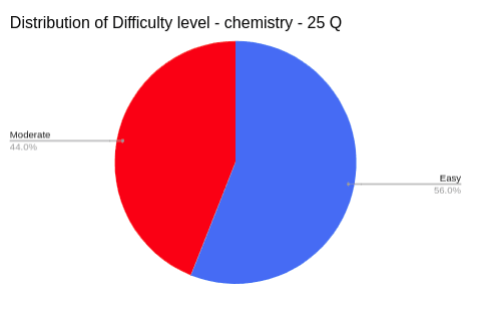
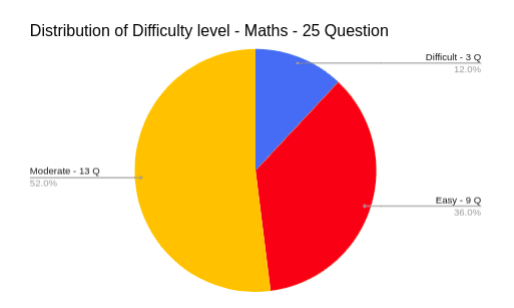
Overall, the difficulty level of the JEE Main 2020 shift one of September 3 was of moderate level. As per the student's reaction, the questions asked in the Physics section were difficult while the questions in Mathematics and Chemistry sections were of moderate level.
Physics - Most of the questions asked in the JEE Main 2020 Physics September paper were numerical based on equations and concept studied. A total of 25 questions were asked out of which 5 % were difficult, 5 % easy and rest were of moderate difficulty.
Chemistry - Out of 25 questions, 4% were difficult, 52% east and the rest were of moderate level. The chemistry paper of JEE Main September 3 shdt one has given more weightage to physical chemistry.
Mathematics - Almost 64% of the questions asked in this section were of moderate difficulty level.
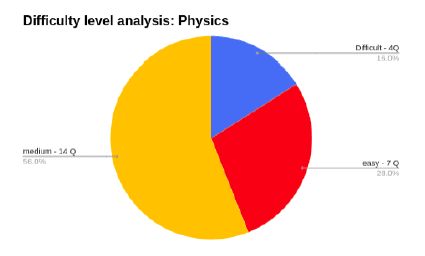
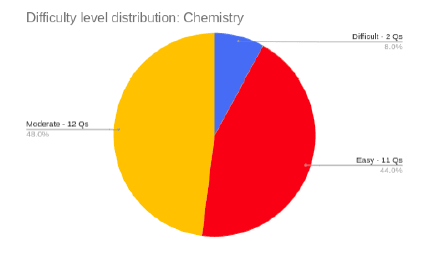
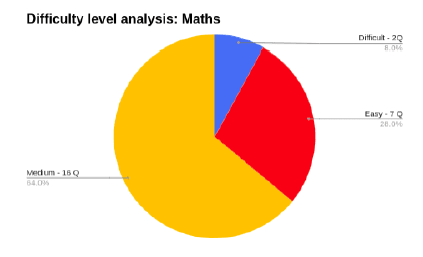
According to the Careers360 's expert faculties, the JEE Main 2020 September 2 paper was of moderate level. The questions asked in the Physics section were easy compared to questions in the Maths and Chemistry section.

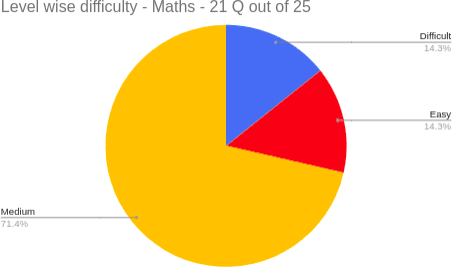

| JEE Main September Exam Day | JEE Main answer key link |
|---|---|
| JEE Main 2020 Paper 2 answer key and solutions | JEE Main 2020 Paper 2 answers key |
| JEE Main Paper 1 answer key pdf September 2 Shift 2 | JEE Main 2020 September 2 Shift 2 answer key |
| JEE Main 2020 September 3 answer key with solutions pdf (Shift 1) | JEE Main 2020 September 3 answer key |
| JEE Main 2020 September 4 answer key | Available soon |
| JEE Main exam (September 5) Shift 2 | JEE Main exam September shift 2 answer key |
| JEE Main (September 6) Shift 1 | JEE Main 2020 September 6 shift 1 answer key |
Slot | Physics | Chemistry | Mathematics |
|---|---|---|---|
April 8, slot 1 | |||
April 8, slot 2 | |||
April 9, slot 1 | |||
April 9, slot 2 | |||
April 10, slot 1 | |||
April 10, slot 2 | |||
April 12, slot 1 | |||
April 12, slot 2 |
Paper | Question Paper | Answer Key |
|---|---|---|
JEE Main Paper 2 (April 7) | ||
JEE Main Paper 1 (April 8) | _ |
Date of Exam | Forenoon Shift | Afternoon Shift |
|---|---|---|
January 8, 2019 (Paper II) | Click Here | Click Here |
January 9, 2019 (Paper I) | ||
January 10, 2019 (Paper I) | ||
January 11, 2019 (Paper I) | ||
January 12, 2019 (Paper I) |
Candidates can check below the JEE Main analysis by Careers360 for all shifts and dates conducted from January 8 to 12, 2019.
Morning Shift | Afternoon Shift |
|---|---|
|
|
Morning Shift | Afternoon Shift |
|---|---|
|
|
Morning Shift | Afternoon Shift |
|---|---|
|
|
Morning Shift | Afternoon Shift |
|---|---|
|
|
On Question asked by student community
Hello,
Don't worry even if you give the wrong birthplace address in the JEE Main application, because the NTA provides the correction window. Still, it can affect the domicile/state quota. So, you must correct these mistakes in the correction window.
I hope it will clear your query!!
Hello,
Choosing CSBS engineering at Techno Main Salt Lake for the 2026 session can be a good option. The CSBS course focuses on both computer science and business skills, which helps students become job-ready for roles in technology, analytics, and management-related fields.
The placement performance for this branch is generally good. Students usually receive offers from software companies, IT services, product-based companies, and analytics firms. The usual salary range is around four to six lakh per year, and higher packages are possible for skilled students.
The academic fee for the CSBS program, excluding hostel charges, is typically between three to four lakh for the full four-year course, though it may change slightly depending on the year.
If you are unsure about your entrance exam rank, you may still get admission depending on counselling rounds and seat availability. If you are interested in computers, programming, logical thinking, and learning business-related subjects along with technology, CSBS can be a suitable and practical choice for your future.
Hope this helps you.
Hello,
The session 1 of JEE mains exam is starting from January 21 to 30, 2026 and session 2 from April 2 to 9, 2026. The format for this examination is computer based. This prestigious engineering examination conducted by National Testing Agency is a first step towards getting an admission in one the IIT's, later through JEE Advanced.
https://engineering.careers360.com/articles/jee-main-exam-dates
Thank you.
Hello,
You can access the JEE Main 2026 sample papers (Physics, Chemistry, and Mathematics) with answer keys from the mentioned link below:
https://engineering.careers360.com/articles/jee-main-sample-papers
Hope it helps.
Hello,
If you mistakenly registered as a General category candidate for JEE Mains 2026, but you actually belong to OBC-NCL, you cannot change the category unless the correction window specifically allows category correction. The National Testing Agency (NTA) sometimes provides the option to edit category during the correction window, but this is not guaranteed every year.
If category correction is allowed, you can upload your valid OBC-NCL certificate and update your category. If the correction window does not allow changing the category, then you will have to appear as a General category candidate for that attempt and will not be able to claim OBC-NCL reservation benefits for that session.
Make sure to keep checking the official correction notice to see which fields can be edited.
Hope this helps you.
Among top 100 Universities Globally in the Times Higher Education (THE) Interdisciplinary Science Rankings 2026
NAAC A+ Accredited | 40LPA Highest CTC | 4480+ Job offers | 620+ Recruiters
Ranked #43 among Engineering colleges in India by NIRF | Highest Package 1.3 CR , 100% Placements
Recognized as Institute of Eminence by Govt. of India | NAAC ‘A++’ Grade | Upto 75% Scholarships
Hands on Mentoring and Code Coaching | Cutting Edge Curriculum with Real World Application
Attempt JEE Main online mock test based on the updated syllabus. Check your preparation and identify your weak points.